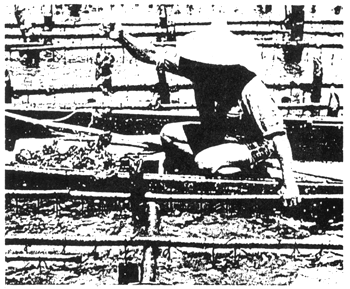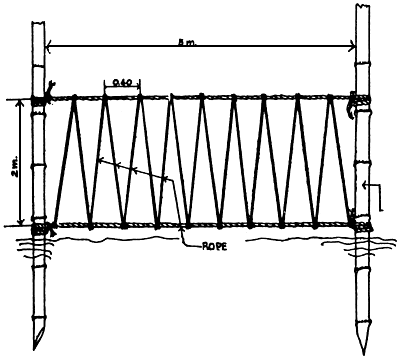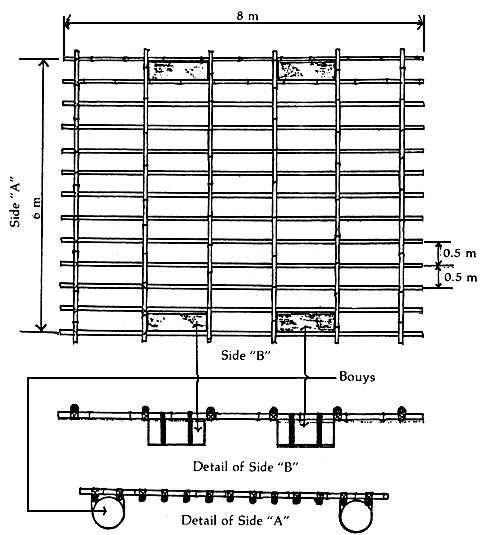The farming methods of oyster are still generally traditional using the stake, hanging, longline; broadcast methods and lattice-tray method.
The broadcasting technique is the most primitive wherein empty shells are scattered on the oyster bed. Oyster spats settle on these shells and harvested by diving or hand-picking at low tides. This method can only be used in very shallow areas with firm bottom which are generally exposed at low tides.
The stake method is usually practiced in soft, muddy and shallow beds, usually not more than 1 m deep. Bamboo stakes are simply stuck in the oyster bed which serve as spat settlement (Figure 8). The stakes are usually as high as the prevailing. tide level in the area.

Figure 8. Oyster farming by stake method (PCARRD, 1983)
This method is better than the broadcast method in that the growth of oysters is faster and mortality of spats on settlement to the stakes is reduced. However, they are more prone to predation by crabs, star-fishes and shell borers. Bamboo as stake material is costly; it does not also collect as much spats as the oyster shells.
Both the broadcast and stake methods do not transplant spats after settlement They are left to grow where they have settled. This is not so in the hanging method. Some-times when the spat settlement is dense, the strings of cultches are moved farther apart to avoid too much congestion. Smaller oysters are also left behind during harvest for further growth.
This uses strings of empty shells as cultch collectors. Strings made of nylon or polyethylene twine are provided with spacers or knots of 10 cm interval at which the empty shells are held. The length of the string depends on the location of the oyster plot. In most cases these are located in an inter-tidal zone along the coastline with depths of 1–2 m. These strings are hung or fastened to bamboo or wooden framework (Figures 9a and 9b) at 25–30 cm apart. The advantages of the hanging method are that the productivity is higher; the oysters grow with thinner shells and high quality meat; harvesting is easier; there is less mortality due to predators. However, the cost of production is higher. This method can be applied in places where natural populations do not exist but favourable for growth of oysters or mussels.

Figure 9a. Bamboo plot for hanging oyster string-collectors

Figure 9b. Harvesting oysters by untying hanging collectors (PCARRD, 1983)
Four parallel lines of about 20 m long and 20 cm apart are strung between two bamboo or wooden posts. Strings of threaded oyster shells held every 12–15 cm apart by small plastic or bamboo tubes are hung on the line. This is actually a modification of the hanging method but the framework where the threaded strings of oyster cultches are hung is made of rope or polyethylene twine.
Bamboo splits are woven into a lattice and tied with galvanized wire, nylon or polyethylene twine. The splits are spaced 15–30 cm apart. The lattice can be positioned like a tray horizontally or vertically. They can be installed in a triangular position supported by bamboo or wooden support.
In Malaysia, instead of using bamboo lattice trays, wire mesh trays supported with wooden frames are used. These are held on wooden stands or racks which are installed in tidal flats.
All these methods are applied in intertidal zones along shallow coastal areas which become exposed at low tides. Usually they are close to residences of small fishermen and populated localities like Binakayan and Bacoor towns in Cavite province; Binmaley and Dagupan in Pangasinan province. These are major oyster producing areas but domestic waste loading of nearby waters is quite high due to dense population and lack of sewerage treatment systems.
Mussel farming techniques also employ the stake method as in oyster farming. Bamboo stakes or mangrove trunk and palm tree trunks are used. As much as 5 000 stakes could be stuck on a mussel bed with an area of 0.25 ha. About 2.5–15.0 kg/stake could be produced by this method.
A modified stake method called the wigwam method is also used. About 7–10 stakes or poles are stuck to the mud bottom in a 2 m radius from a central pole. The upper ends of the poles are tied to the center to form a wigwam. This is used in deeper water areas with stronger water movement. The poles serve as spat collectors but no thinning nor transplantation of spats is made.
The same principle of hanging method in oyster farming is also used for mussel. However, coconut husks are used as cultch collectors besides empty oyster shells. This method is applied in deeper water areas as the mussels do not need exposure like the oysters.
This method was introduced in Sapian Bay, Capiz. A unit of rope-web consists of a parallel pair of ropes measuring 5 m, positioned at 2 m apart, connected in a zigzag pattern at 40 cm intervals between knots along each parallel rope (Figure 10). Bamboo pegs of 20 cm long and 1 cm in width are inserted in each zigzag rope spaced at 40 cm between pegs. This prevent the oyster clusters from sliding down the rope as they grow bigger and heavier. The distance between posts is 5 m; the rope-web is stretched 3 m apart along the rows. Rope-webs are installed parallel with the water current and positioned 2 m deep at low tide. These are untied at harvest and reused for subsequent cropping cycles. The rope-web method can produce up to 300 t/ha/yr if the spatfall is heavy; on the average, 200 t/ha/yr is produced (shell on) (Young and Serna, 1982).

Figure 10. Diagrammatic drawing of a rope-web tied to bamboo poles (PCARRD, 1983)
A raft may be made of bamboo or wooden pontoons with cross beams buoyed up by empty metal or plastic drums, old car tires blown with styrofoam or ferroconcrete buoys (Figure 11). Rafts are installed parallel to the flow of tide.
A unit of raft may be 6 m × 8 m or 8 × 5 m. Collector or growout ropes are hung on the raft. Collector ropes are shorter than grow-out ropes. Both are provided with weights to prevent them from floating. Collector ropes are hung at about 0.5 m apart while the growout ropes at 1 m apart. Abaca rope or polycoco ropes are used as growout ropes. They are provided with bamboo pegs of 25 mm long × 1.5 cm wide which are inserted into the lay of the rope at 30 cm interval. These pegs prevent the growing mussels from slipping. A one-meter rope can hold 5–15 kg of mussels. Growout ropes could be as long as 4 m long depending on the depth of the mussel farm.

Figure 11. Construction detail of a mussel raft using bamboo framework and floats (Source: Yap, W.G., el. al., 1979)
In Singapore, spat collector ropes are hung at 8 ropes/m2 which are spread out to 4 ropes/ m2 for growout. At this density the level of production attained ranged from 100 to 160 kg/m2 every six months (Cheong, 1982).